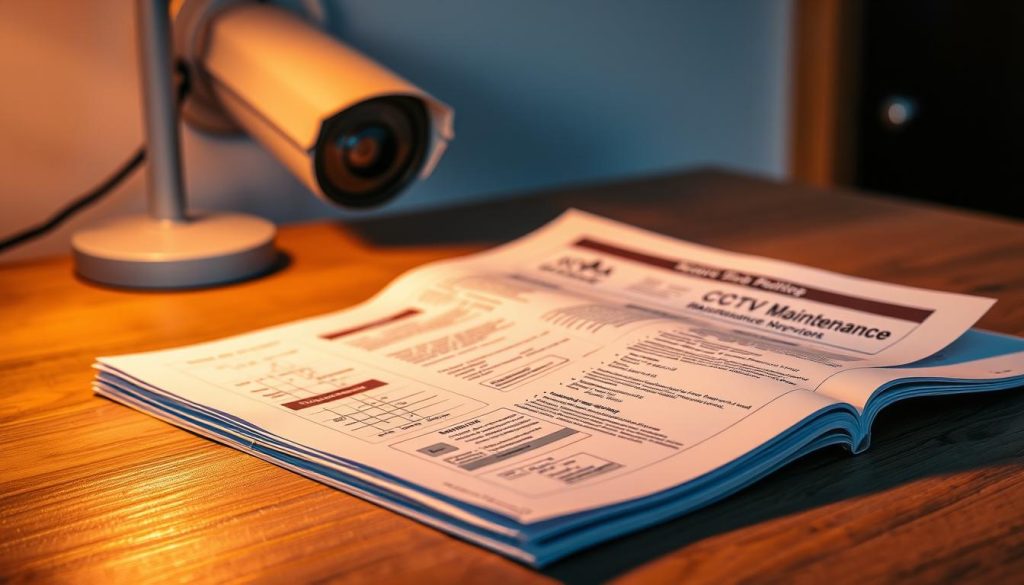Writing a detailed CCTV maintenance report is key to keeping surveillance systems running smoothly. It’s not just for security but also for following strict Singapore CCTV rules. By using set guidelines, you can keep track of all CCTV maintenance. This makes your security system more reliable.
This method also helps meet legal requirements, protecting your security efforts. It’s all about keeping your surveillance system in top shape.
Key Takeaways
- Effective documentation enhances surveillance system reliability.
- Adhering to CCTV reporting guidelines is critical for compliance.
- Regular upkeep is essential for the longevity of CCTV equipment.
- A well-crafted report supports legal compliance in Singapore.
- Structured reporting streamlines security management processes.
Importance of CCTV Maintenance Reports
CCTV maintenance reports are key to keeping surveillance systems running well. The importance of CCTV maintenance is huge. It keeps equipment working long and helps it perform better. These reports help spot problems early and fix them fast, keeping security systems up and running.
Benefits of Regular Monitoring
Regular checks, thanks to CCTV reports, bring many benefits. Some top benefits of CCTV reports are:
- They help find problems early, making systems more reliable.
- They make sure all cameras are working, boosting safety.
- They provide the records needed for audits and reviews, helping make smart choices.
Legal Compliance in Singapore
In Singapore, following the law with CCTV systems is very important for businesses. Maintenance reports are key to showing you follow the rules. Keeping detailed records helps you stay accountable and avoids legal trouble.
Understanding CCTV System Components
Knowing the parts of a CCTV system is key for good surveillance and security. Each part, like cameras and recorders, has its own role. This knowledge helps improve performance and ensure full monitoring.
Key Parts of a CCTV System
The main parts of a CCTV system are:
- Cameras – They capture the video, acting as the system’s eyes.
- Recorders – They save the footage for later review and analysis.
- Transmission Media – They help send video from cameras to recorders.
- Power Supply – It gives the energy needed for all parts to work.
- Monitors – They let you watch the surveillance footage live.
Various Camera Types and Their Functions
There are many types of CCTV cameras for different needs:
- Dome Cameras – Great for indoor use and have a hidden design.
- Bullet Cameras – Best for outdoor use, they can see far away.
- PTZ Cameras – They can move, tilt, and zoom, covering big areas well.
- Infrared Cameras – Perfect for seeing in the dark or low light.
Understanding the different CCTV cameras and their uses helps choose the right ones for each security need.
Why Regular Maintenance is Crucial
Regular maintenance of CCTV systems is key to keeping surveillance setups effective. It helps businesses protect their assets and saves money in the long run.
Extending Equipment Lifespan
Regular checks extend the life of CCTV equipment. They catch small problems before they get big. This can make CCTV parts last up to 40% longer.
Putting effort into maintenance means less downtime and better performance. It’s a smart way to keep your surveillance running smoothly.
Cost-Effective Surveillance Solutions
Maintaining CCTV systems wisely saves businesses money. It prevents expensive repairs and system failures. This way, you avoid security breaches and keep costs down.
Regular maintenance is a smart investment. It protects your business’s physical and financial security. It’s a key part of keeping your surveillance system in top shape.
How to Write CCTV Maintenance Report?
Creating a detailed CCTV maintenance report needs focus and order. A good report covers all key parts of the inspection. Start by collecting all needed info to make the report useful and informative.
Gathering Necessary Information
To write a CCTV maintenance report well, start by collecting maintenance data from past records and current checks. Key points to note include:
- System status and performance metrics
- Maintenance history from past inspections
- Details of any specific tasks done during maintenance
Using a Clear Structure
Structured CCTV reports should have a clear layout for easy reading. Begin the report with a quick maintenance summary, then:
- Include detailed observations from the current maintenance cycle
- Report any issues found during the inspection
- Offer suggestions for future maintenance tasks
Steps for Creating CCTV Maintenance Reports
Creating effective CCTV maintenance reports is a detailed process. It ensures your surveillance systems work well. By following these steps, you’ll make your reports reliable and boost your security monitoring.
Conducting Routine Checks
Routine maintenance checks are key to good CCTV management. They make sure everything is working right. You should check:
- Camera clarity to verify clear surveillance footage.
- Cable integrity to prevent disruptions in the signal.
- Recording devices to confirm they are properly storing images.
Doing these checks often is the first step to making CCTV reports that show the system’s real state.
Documenting Findings Accurately
Accurate documentation is essential for a good CCTV system. Every detail from the checks must be written down carefully. This includes:
- Identifying any issues discovered during inspections.
- Detailing actions taken to address these issues.
- Tracking the overall system condition over time.
Keeping detailed records improves your reporting quality. It also helps you understand the system’s performance and maintenance needs better.
CCTV Maintenance Report Template
Creating a CCTV maintenance report template can make reporting much easier. A good template focuses on key parts for reports. This lets you include important info in an organized way.
Basic Structure Elements
Important parts of reports include titles, dates, and summaries of maintenance done. You should also include findings and repair recommendations. Each part should be clearly labeled for easy reading.
This makes understanding the report better. It also helps follow industry standards.
Simplifying the Reporting Process
Using checklists in your CCTV report template can simplify things. They help list tasks in a clear, systematic way. This makes it easier for people to do their jobs well during maintenance.
Checklists are very helpful. They reduce the chance of missing important steps. They also make sure all necessary info is documented.
CCTV Report Formatting Tips
Formatting CCTV reports well is key to making them clear and easy to understand. Using the same fonts and styles helps a lot. This makes it simpler for people to read and understand the important details.
Using Consistent Fonts and Styles
Keeping the same font and size in your report makes it look good. It shows you’re serious and reliable. Pick fonts like Arial or Times New Roman that are easy on the eyes.
Make sure the size of the text is the same for headings and body. This makes your report look neat and clear.
Incorporating Visual Aids
Adding pictures, diagrams, or charts can really help people get what you’re saying. It’s great for those who don’t know a lot about technical stuff. Visual aids make complex info simple to grasp.
So, using pictures and charts in your reports is a smart move. It makes your report clearer and more useful for everyone.
Writing Effective CCTV Maintenance Reports
Creating effective CCTV reports is key to keeping surveillance systems working well. Clear reports help everyone understand important information fast. They should be easy to read, so everyone can understand them, no matter their tech skills.
Clarity and Conciseness in Reporting
An effective CCTV maintenance report should be clear and to the point. Avoiding hard tech terms makes the report easy to get. This way, everyone can understand the main points without getting lost.
Using simple language helps build trust in the reports. It shows that the information is clear and reliable.
Including Relevant Data and Metrics
Adding the right data to maintenance reports makes them more valuable. Things like camera uptime, incident logs, and service history are very important. They help make smart choices about the equipment.
These key numbers give readers the info they need to see how well the system is working. Good CCTV reports are essential for keeping the system running smoothly.
CCTV Service Report Structure
A well-structured CCTV service report is key to good surveillance management. It helps everyone understand and talk about the report clearly. To make sure it’s complete, you need to include all the important parts. This makes the report easy to follow for readers.
Essential Sections to Include
When making a CCTV service report, think about these main parts for better organization:
- Executive Summary: This part gives a quick overview of the report. It summarizes the main points and what you suggest.
- Detailed Findings: Write down what you found about the system’s work. This includes any problems or what needs fixing.
- Actions Taken: List what you did to fix the issues. This shows you’re responsible and open about your actions.
- Recommendations: Share ideas for making things better. This could be upgrading the system or changing how you maintain it.
- Audience Tailoring: Make the report fit the audience. This means it should be clear for both the bosses and the tech team, with info they need.

Common Mistakes in Writing CCTV Maintenance Reports
Writing a detailed CCTV maintenance report is key for good surveillance management. Many mistakes in CCTV reports can cause big problems during maintenance. One big mistake is using vague language. This can hide important issues that need fixing.
Being clear in reports helps all technicians understand the problems. This makes fixing issues faster and more effective.
Avoiding Vague Language
To make reports better, it’s important to avoid vague language. Being specific helps everyone understand and act on the information. Instead of saying “a problem occurred,” it’s better to be clear about what the problem is.
For example, saying “the camera is not working” is not as helpful as saying “the camera image is not displaying.” This clear information helps in finding and fixing the issue faster.
Also, submitting reports on time is very important. Delaying reports can make problems worse. This can lead to technical issues that might not meet regulations. Being quick and detailed with reports makes CCTV systems more reliable. For more tips, check out this link.
Technological Tools for Enhancing Reporting
Using technology for reporting in CCTV maintenance makes things easier. Advanced software helps track and report automatically. This makes reporting more efficient and accurate.
These software tools also support compliance with industry standards. They allow for quick access to data. This helps security teams respond faster to incidents.
For more on effective maintenance reporting, check out this informative guide.
Adopting these tools is essential in today’s fast world. They make workflows more efficient. This leads to better security measures.

